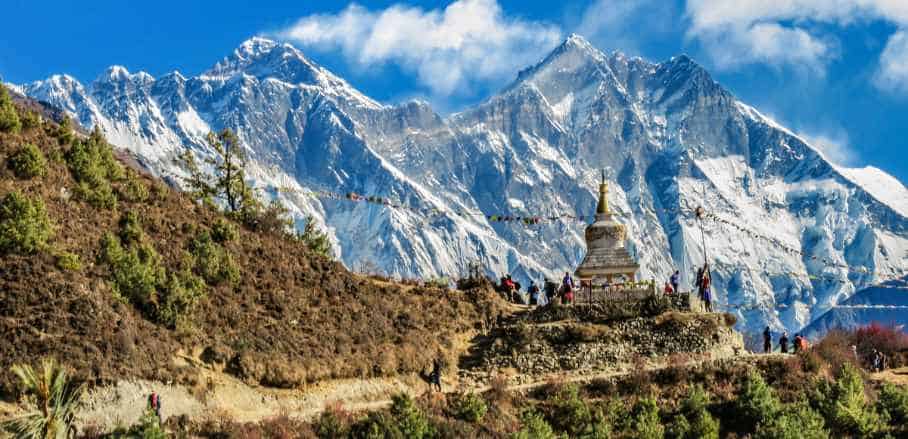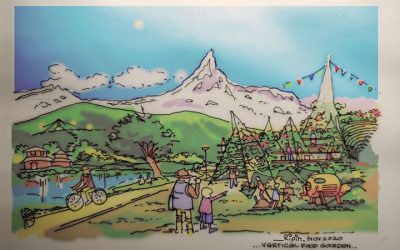Hand in Hand With Nature For the Future of Urban Nepal
Nepal belongs to one of the least urbanised regions in the world, while also being one of the fastest-growing countries. This poses tremendous challenges for its sustainable future. By Ripin Kalra
Nepal—often known as “the majestic Himalayan Kingdom” and now a fully-fledged democracy—is one of the least urbanised countries in the world. Its urban population is only 26 per cent of the total population, and much of that is concentrated in the Kathmandu Valley.
However, Nepal is also one of the fastest-growing urban countries in the world, with an urban growth rate estimated at 6-8 per cent, well above the 3-4 per cent average in the South Asia region. Globally, most fast-urbanising areas are hungry for land and space to expand. But with Nepal located in a flood and earthquake zone, finding safe spaces for any necessary urban expansion is important.

Stupa, Namche Bazaar, Nepal © Sebastian Pena Lambarri/unsplash
Nepal is also at high risk of effects from global greenhouse gas emissions that lead to climate change. The abundant glacial cap in Nepal—often referred to as the Third Pole—is melting at a faster rate than previously recorded. Melt from the Himalayan glaciers is a source of freshwater for more than 1 billion people in South Asia. This rapid urbanisation is driving sustainable urban development in Nepal, not only in shaping its future cities and economy but also in the ecology of the Himalayas and the broader South Asian watershed.
The Ecological Bedrock of the Economy in Nepal
The main engines that drive Nepal’s economy are tourism, agriculture, and remittances from overseas Nepali workers, along with tourists who visit to enjoy and explore Nepal’s majestic Himalayan terrain and biodiversity, also known as its “green gold.” There are also multiple rich cultural heritages to enjoy for those interested in Himalayan architecture, Buddhism, and Hinduism. The Himalayan terrain and its ecosystem are the true bedrock of the environment and economy in Nepal.

“Vertical food garden” © Ripin Kalra, 2020
Much of Nepal’s industry and tourism-related crafts are concentrated in urban areas, particularly the Kathmandu Valley. Nepal’s urbanisation has coincided with gross domestic product growth, much like in other areas around the world, helping to create jobs, reduce poverty, and improve living conditions. However, with urban jobs being primarily in the informal sector, and other than remittances from overseas, the Nepalese economy relies heavily on the tourism, hospitality, and heritage sectors.
Sustainable urban development in Nepal, therefore, is a complex interplay between the demands of a nature-based economy; the needs of a large, ageing workforce with limited financial protections; and the protection of highly sensitive ecological zones from unnecessary urban expansion.
Since Nepal’s key economic resource is nature, a sustainable city must therefore be built around nature. Considering the rapid urbanisation rate, this is no easy feat – especially considering there are many problems associated with rapid growth: unplanned housing (e.g., squatter settlements or shanty towns), dealing with urban waste, pollution, and stress on infrastructure and city services. In Nepal in particular, finding informal housing sites that are safe from landslides, flooding, or earthquakes is difficult.
In addition, climate-change-induced migration to urban areas is expected to intensify over the coming decades, further driving urbanisation. Indeed, the fastest-rising cause of migration in South Asia, and specifically in Nepal, is climate change, as evidenced by the many rural communities that shelter in towns and cities after forest fires, floods, and landslides—all climate-related disasters.

Pokhara is the second largest city of Nepal and has seen its urbanisation rate double in the last two decades © Samrat Khadka/unsplash
How the COVID-19 Virus Impacts Sustainable Development in Nepal
Additionally, COVID-19 caused the socio-economic gap to increase. Those working in the service industry and the informal sector who lost jobs or livelihoods also had an increased risk of contracting COVID-19. As a huge number of migrant workers returned, few job opportunities are available, unemployment rates have risen (World Bank, 2020), and the ICF programme Nepal Urban Resilience Project (NURP) reports a rise in gender-based violence during the lockdown period and a need for municipalities to quickly ramp up health services.
In April 2021, the ICF NURP team organised a municipal-to-municipal practice exchange dialogue (part of the Resilience Chhalphal series) on Urban Disaster Risk Reduction and Management and implemented a range of green infrastructure projects (e.g., freshwater pond restoration, river embankment protection, tree planting, cycle tracks, cold stores for agricultural produce). This provides short-term, additional income that will enable Nepalese to learn new skills and start looking ahead towards a green recovery from COVID-19.
The Future of Sustainable Urban Development in Nepal
Clearly, urbanisation is here to stay in Nepal for the foreseeable future, making demands on land and resources and requiring people to learn new skills in response to the multiple hazards the country is exposed to. The biggest lesson learned from the COVID-19 experience is that the economy is highly sensitive to shocks and stresses from pandemics and other disasters, and it needs a thoughtful approach that will protect the ecology (the bedrock of the economy) and lead to a green post-pandemic recovery.

Comic © Ripin Kalra, 2021
Under NURP, risk- and inclusion-sensitive land-use planning (RISLUP) is paying close attention to spatial growth for towns and cities in safe zones, specifically in vulnerable communities that are most in need of affordable sites for better and safer living conditions. Much of the economy will continue to depend on the restoration of water bodies (Butwal) and parks (Pokhara) under NURP that highlight the essential protection of the ecological resources of Nepal.
It is also highly important to educate across all demographics, including women and young people, to carry out a range of income-generating green skills such as urban farming, electric vehicle maintenance, and data management. This will ensure urban communities of Nepal have a wider pool of skilled people who can service the urban areas and businesses of Nepal.
Yes, nature is Nepal’s biggest asset – and by conserving and building around nature, Nepal has an opportunity to create truly liveable, resilient and ‘ecophilic’ cities for all. Managing new green infrastructure alongside old heritage, Nepali cities can become sustainable and even more attractive destinations for
both domestic and international visitors.
- Hand in Hand With Nature For the Future of Urban Nepal - 19. October 2021
